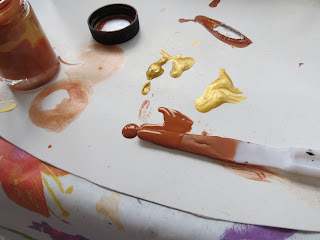What you will need
1) Black pastel
2) Burnt Sienna pastel
3) Burnt Umber pastel
4) White acrylic
5) Paint Brush
First lets go over shading -- I have yet to figure out how to properly shade with an airbrush, so as I try different techniques I use a mixture of different color pastels to shade. I mix together black, burnt sienna, and burnt umber pastel in a cup. Then I choose which muscles to define -- this is a personal preference of mine, you can define all muscles if you'd like.
It should start out like this-
And after you shade it should look like this-
Now since your using pastel make sure to seal with acrylic sealer- I use Krylon.
Lets go over white markings- I like to use artist quality brushes and paint. The brushes are less likely to leave brushstrokes and hair in the paint. The paint has more pigment in them so when you thin the paint down you get more color.
You should thin the paint down to the consistency of skim milk, when you lay the paint down you should still be able to see the color through the white.
After this you keep painting layers of white until it is solid and has no visible brush strokes.
 |
| after about 10 more layers of white |
You don't need to seal between each layer unless you feel the layer before it pulling. After your done with the white all you have to do is the mane/tail, hooves, and eyes.
I will cover how to do the mane/tail, hooves, and eyes in separate posts. If you have any tips on the content covered here feel free to comment in the comment section.































